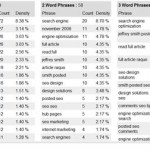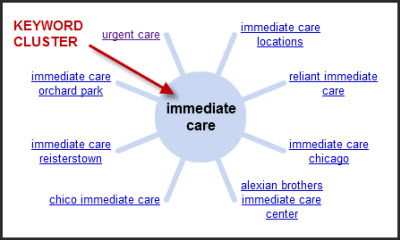Should you build links for competitive vertical search terms or focus on less competitive keywords? Heads or tails? Sounds simple enough right? When it comes to link building, it just depends on your approach.

Some say start with the top tier terms in the titles and tags and other argue to start at the long-tail and work you way up. One thing is certain, there are advantages and disadvantages with each or rather aspects which should be clear before embarking on a keyword quest to overthrow the SERPs.
High Flyers: You know, that one company (there’s one in every niche) that dominates the root phrase for that industry. It really doesn’t matter if everyone loves, admires or loathes them for their search engine position, the fact is, that companies like this are what keep SEO’s in business.
The proof is in the pudding when you get multiple calls a week from Company B wanting to know how Company A got the ranking for terms X, Y & Z (highly competitive industry keywords).
So, naturally you take a peek under the hood and see thousands of links percolating like a finely tuned V-12 Ferrari engine ready to race anyone who attempts to claim their combination of key phrases. In all actuality companies such as that should be thanked for for taking the lead when others were simply thinking about vertical off line strategies. But in any case, it doesn’t make it too difficult to explain why they rank the way they do.
Understanding this, the whole quandary of links and link development start to unravel the details for milestones they used to achieve this feat. Despite the fact that first thing that comes to mind is, how in the hell did they get that term and how to they maintain it. The obvious answer, research, strategy and patience.
Terms that are two word phrases for example, take time and are usually the last to come on line in regard to search engine optimization. A high flyer has just as much on page as well as off page requirements to make sure that the link architecture supports the main pages which need the concentration of the inbound links to make them themed in nature. The secret here is start with a broader focus and narrow the keywords over time.
Link Building Strategies
One method (for internal linking) is, you can use links on the footer of your pages with absolute links and keyword-rich anchor text to (a) assist in the search engine indexing process and (b) provide site-wide reinforcement of your main keywords.
Another method is, study theming and siloing for your site structure and then build links to each sub folder strategically using a variety of anchor text. This will ensure that each page has the ability to stand on it’s own over time while giving valuable link juice back to the root folder (which in turn gives it back to the sub folders) to create a dynamo.
And yet another method suggests you can keep the pages structured and have a high number of inbound links to each page in your site, which can produce keyword dominance for each page in the site as well as spread out and take over the long tail. With this method, you are better off leaving each page as an island to itself and forget about excessive internal links.
If you use this method make sure that the title tags have the goal in mind, use the most competitive keywords without stuffing them (not the 3 or 4 word diluted versions of the keywords). This is important because it is hard to retool your tags later for terms higher up, whereas you can rank for less competitive terms by simple off page link building alone.
Naturally, very few SEO’s are going to tell you specifically how to optimize a competitive term, unless that is they simply wanted to be a resource instead of an SEO company, but at least by making general references you can assist others to find the right method which works for them. Aside from competition, domain age, your hosting environment and server side issues it really is ultimately up to the content, the links and the variety of methods you use to augment website authority such as link building, web 2.0 viral marketing, article marketing, etc.
Riding the Long Tail:
Having 1000 searches per day from the long tail vs. 1000 searches per day from the head of the dragon? Which one is better? Terms too general / broad don’t convert as much, but once you have them, then you can narrow your focus for essentially any regional or local reference with those keywords. Or on the contrary just 10 of those searches from the top could essentially land you the client of your dreams, so determining the most appropriate strategy is first and foremost winning half the battle.
On the contrary to the above, you could also build your site for the long tail of search by removing your meta tags & building links like mad without using anything except for a title and let the spiders do their thing. Trust me, they will find the content they are looking for, but using the ground up approach is great for an industry that is riddled by serious competition. So having multiple top 10 rankings all add up and eventually move your overall site up in the rankings to the more competitive terms organically.
The only problem or setback for using this method, is at some point, you will have to change you approach, tags, titles or tactics to take it up a notch and you could essentially botch the smaller islands of top tens while you shift the focus. It’s almost like 6 in one hand half a dozen in the other, but if managed properly you can have your cake and eat it too.
Hit em high and Hit em Low:
Here is what we have all been waiting for, competitive queries returning relevant on topic decision makers to your site, while still cleaning up on anything you point a stick at with your blog or new pages. This is the crowning achievement of search, to be able to rank well for the main search terms (through tactful linking) as well as having enough authority from the root of your site so that you can rank for a term by reference to it alone.
The whole hit em high and hit em low link strategy is nothing more than this.
1. Build your site themed from the start using W3C compliant code, or tweak your word press blog using some killer plug ins.
2. Start building links to the folders / sub folders using the top 100 keywords that appear in the keyword research tools you use. This way you cover the long tail naturally as you progress.
3. Start with 4 word terms, then go into 3 word combinations, move down to the two word terms and then start building multiple links to pages using one word per link (article marketing is great for this).
4. Observe the effects, run reports, see where you stand on the long tail using tools such as SEO Digger, that reverse engineer search engine algorithms. Then add quality links specifically to the pages with the highest concentration to they keyword in question to that page site:www.yourdomain.com [keyword] will let you know which page is already the perfect match.
5. Check your stats, see which terms convert, I suggest using hittail which has a built in feature that suggests new keywords based on your long tail traffic patterns (a simply brilliant program designed by Mike Levin). Then you will not waste any time going after the wrong terms which after months yield only marginal results.
Granted these methods proposed above are not the absolute rules of search, nor is there any guarantee that the algorithms will not change the minute after this post goes live. The point being they are thought provoking methods that have their roots in thousands of hours of trial and error and they do in fact work.
To which degree is a derivative of just how far you push the envelope, since essentially through using either method you will ultimately end up in the same place (with multiple top 10 rankings). So, this is merely a method whereby you get to grab your site by the reigns and find out where the highest conversion results from as a result.
I hope you found this information useful. If so, then pass it web 2.0 style by placing your vote, linking to it or leaving a comment, or if you are interested in competitive SEO rates for a project then simply follow the link.









Great post Jeffrey. I sure have been reading the phrase,”it’s in the pudding lately.” It’s nice to see someone write something of value. Keep it coming. Really enjoyed the read. Portal Feeder is opening its doors again on Dec. 4th,2007 at http://portal-feeder-review.com. This is truly a great resource to keep you up to date on the latest in internet marketing, seo, etc..
Where’s that emoticon of the two hands applauding and clapping when you need it?
*applause* *applause*
Very nice post.